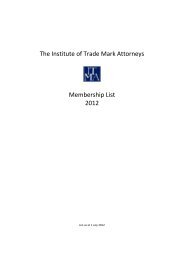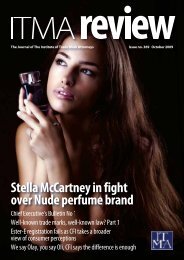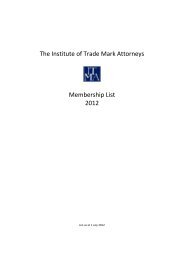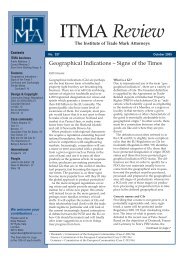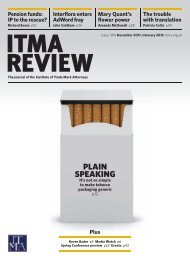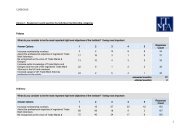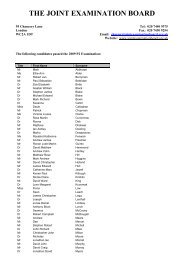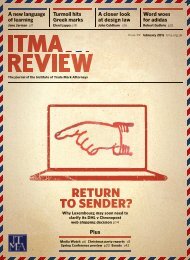ITMA Autumn Conference: Treviso provides cultured backdrop for ...
ITMA Autumn Conference: Treviso provides cultured backdrop for ...
ITMA Autumn Conference: Treviso provides cultured backdrop for ...
You also want an ePaper? Increase the reach of your titles
YUMPU automatically turns print PDFs into web optimized ePapers that Google loves.
Laboratoires Goëmar to support their<br />
genuine use case was irrelevant <strong>for</strong><br />
the purposes of proving genuine use<br />
of that mark. Additionally, whilst the<br />
court did not go so far as to say that<br />
undated evidence should not be<br />
considered, its approach was to<br />
consider only evidence that was<br />
dated within the reference period<br />
or verifiably related to it.<br />
The CFI also refused to accept La<br />
Mer’s contention that some of the<br />
evidence of use should be<br />
disregarded because it related to<br />
non-cosmetic products. Article 43(2)<br />
states that the applicant <strong>for</strong> the mark<br />
may require of the opponent proof<br />
of genuine use of the opposing mark<br />
“in connection with the goods or<br />
services in respect of which it is<br />
registered and which he cites as<br />
justification <strong>for</strong> his opposition”.<br />
Laboratoires Goëmar’s opposition<br />
related to goods covered by their<br />
earlier registrations in respect of<br />
“cosmetics of a marine products<br />
base”. La Mer argued that soaps and<br />
bath additives were not cosmetics,<br />
and that nutritional supplements<br />
fell within Class 5 (pharmaceutical<br />
preparations etc) because they are<br />
taken internally.<br />
The CFI’s response was that soaps<br />
may also be classified as cosmetics<br />
when, in particular, they are deemed<br />
to have cosmetic properties such as<br />
beautifying the skin or when they are<br />
perfumed. The same applied to bath<br />
additives. In respect of the nutritional<br />
supplements, the court considered<br />
that the fact that the products were<br />
taken orally and not applied to the<br />
skin did not prove that the products<br />
were not cosmetic. The court<br />
commented that “the current<br />
tendency… is to market cosmetic<br />
products having… properties which<br />
are allegedly slimming or beautifying,<br />
and which are to be swallowed”.<br />
Packaging, it would seem is not<br />
conclusive – a tablet with a<br />
beautifying function may be<br />
cosmetic, equally “products presented<br />
in the <strong>for</strong>m of phials or individually<br />
sealed quantities are not <strong>for</strong> that<br />
reason medical preparations”.<br />
Likelihood of confusion<br />
On a global assessment, the CFI<br />
agreed with the Board of Appeal that<br />
there existed a risk that the public<br />
November 2007<br />
CASE COMMENT<br />
may believe that the goods in<br />
question came from the same, or<br />
economically linked undertakings, and<br />
that there was a likelihood of confusion<br />
between the marks in question.<br />
As to the similarity of the goods, the<br />
CFI considered that the Board of<br />
Appeal was “right to take the view…<br />
that “soaps, perfumery, essential oils,<br />
hair lotions, dentifrices, toiletries”<br />
under the mark applied <strong>for</strong> and<br />
“cosmetics of a marine product base”<br />
under the earlier mark were “very<br />
similar”. According to the CFI those<br />
products might be sold in the same<br />
outlets and be directed at an identical<br />
category of consumer. In addition,<br />
quite often the manufacturers of<br />
those products are the same.<br />
As to the similarity of the marks, the<br />
court reiterated the principle that<br />
“two marks are similar when, from the<br />
point of view of the relevant public,<br />
they are at least partially identical as<br />
regards one or more relevant aspects”<br />
(see, <strong>for</strong> example, Case T-6/01<br />
Matratzen Concord v OHIM [2002]<br />
ECR II-43). In the present case, the<br />
marks were partly identical. Taking<br />
into account the low distinctiveness<br />
of the word “laboratoire” compared<br />
to the words “la mer”, the CFI found<br />
the conflicting signs were similar<br />
particularly as the only element of the<br />
mark applied <strong>for</strong>, and the distinctive<br />
element of the earlier mark were<br />
identical.<br />
The CFI there<strong>for</strong>e held that a<br />
likelihood of confusion did exist due<br />
to the goods in question being partly<br />
identical and partly similar and the<br />
overall similarity between the<br />
two signs.<br />
Comment<br />
The CFI’s judgment <strong>provides</strong> useful<br />
clarification on several issues. For<br />
example, the standard <strong>for</strong> genuine<br />
use remains unchanged and relatively<br />
low; “minimal use” can be sufficient to<br />
establish genuine use provided it is<br />
not “token use” <strong>for</strong> the sole purposes<br />
of retaining the mark.<br />
Additionally, when determining<br />
genuine use of an earlier mark in<br />
relation to the goods <strong>for</strong> which that<br />
mark is registered, the court appears<br />
to avoid taking a narrow view of the<br />
types of goods that may be classified<br />
as cosmetics.<br />
It appears in this respect that the<br />
functional properties of a product<br />
are more important than how it is<br />
packaged or marketed; a pill may<br />
be cosmetic, a cream or lotion,<br />
medicinal. Having reached that<br />
decision in relation to proof of use, it<br />
is hardly surprising that the court also<br />
considered that the goods to which<br />
the opposing marks related were<br />
very similar.<br />
Teresa Neil, Hammonds,<br />
teresa.neil@hammonds.com<br />
<strong>ITMA</strong> Review 21





